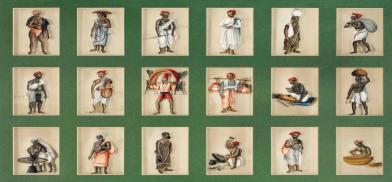Mica art: By Indians, of Indians - for the English
Mica paintings were attractive to many Englishmen because they documented life in 19th century India

A new kind of painting done on thin sheets of mica started being made in different parts of India from the early 19th century. Stylistically they were very different from anything that came earlier. The paint used was English watercolor, mixed with some kind of glue-like Gum Arabic.
Mica in its natural form is found in Bihar and Cuddapah in Andhra Pradesh. It was traditionally used for copying and preserving pictures that could be reproduced when patrons demanded it. It was also used to make decorative lanterns for Muharram, and crushed and scattered on fine cotton muslin in courtly circles.
Mica paintings were made in four centres in India. Beginning in Murshidabad, the art migrated to Patna and thence to Varanasi. In South India, they were made in Tiruchirapalli and Tanjore.
British bought the paintings
Mica paintings were sold in firqas or sets put into the pages of plain white notebooks. Most of these firqas were painted by one artist who or whose family member would also have hawked then in the European quarters of cities like Kolkata, Varanasi, Patna, Murshidabad, Madras and Thiruchirapalli.
These paintings were done by Indians of Indians, even if the patrons were the English. They are a visual document of the lives of Indians, probably the single most extensive visual documentation of life in 19th century India.
Almost unknown to most Indians because they were bought by the British for taking back with them, either for their own pleasure or as gifts for others, paintings on mica are finally being brought back home by many Indians from the United Kingdom.
Very little research has been done about them. There are just three articles, of which only one really gives new information on the circumstances that led to their popularity with the British who were the new rulers of India. Mica paintings were attractive to many Englishmen because they documented life in 19th century India.
India’s scenic life
The household staff in the employ of East India Company officials, bazaar and street scenes, dancing girls and musicians, gods and goddesses, natural history scenes like flowers and fruits, birds and butterflies were some of the most popular.
Besides these there were more elaborate scenes, of festivals, suttee scenes, Mohurrum processions, Kali and Durga Puja, Charak puja with hook swinging - in short, these paintings were as far removed from contemporary English life as it was possible to be.
Stylistically these paintings display an amalgam of Indian subject matter with European artistic sensibilities. So by and large we do not see multiple perspectives being used, though occasionally a table has been tilted forward in the Indian manner to display all its wares clearly to its viewers. Limbs of people are rounded off with cross-hatching or shading, shadows are suggested on the floors or ground.
Props are used minimalistically to suggest whether the scene is supposed to be indoors or outdoors. For example, if you have a swathe of curtains framing the top of the painting, you know it is taking place, indoors; if it takes place outdoors, its often suggested by a branch intruding into the picture from the left or right.
Why was mica used instead of paper, what are the precedents for doing so, what led to this new genre of painting, so completely different from anything attempted earlier, and why did it die out are some questions that I will attempt to answer in a comprehensive book on the genre.
(The author is an art historian with a Doctorate in Art History from the National Museum Institute of Art History, Conservation and Museology. She has collected over 500 paintings from the UK and is now writing a book. The views expressed are personal. She can be reached at shreenairpal@gmail.com)










Post a Comment